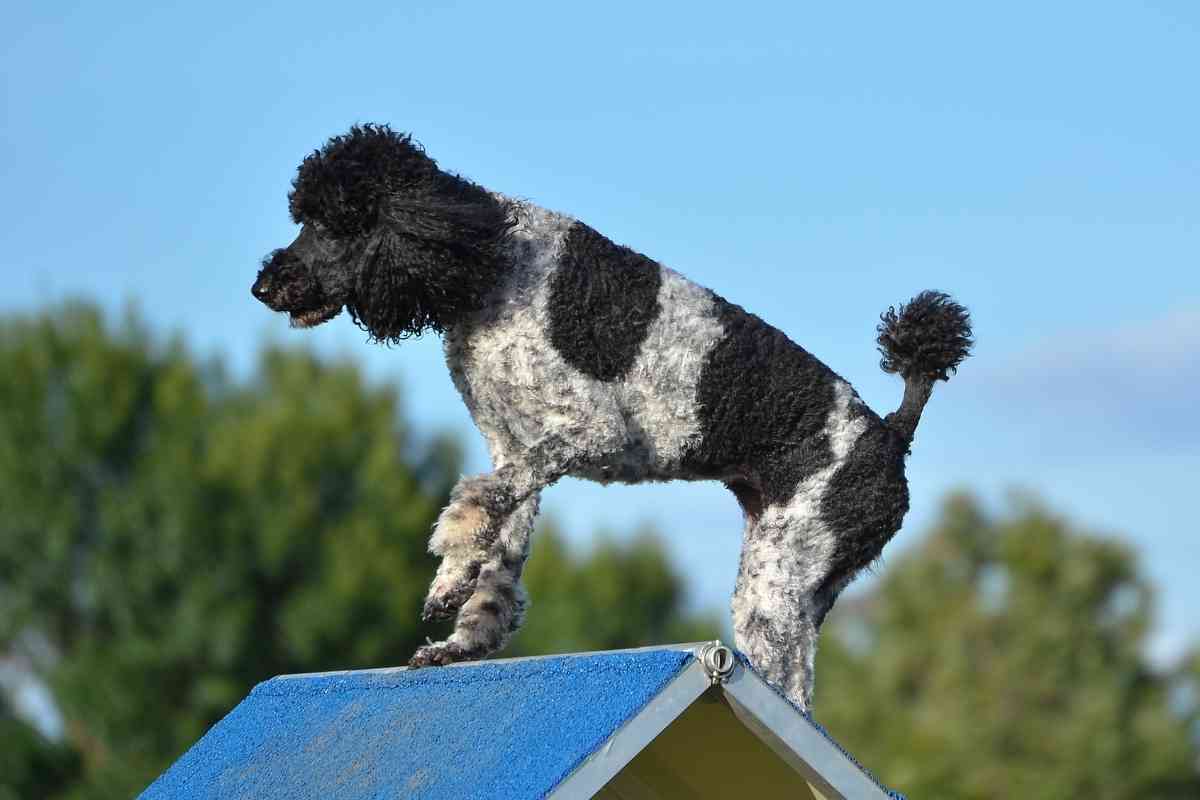Can My Goldendoodle Be Merle?
There are many unique coloring pairs that your Goldendoodle can have. It often depends on what colors the parents were to start with, but the coloring of the Goldendoodle puppies can go across the rainbow, making them really fun dogs to keep around.
As you start to find the perfect Goldendoodle or Mini Goldendoodle to add to the family, you may wonder whether you can find a Goldendoodle with the merle coloring.

Can My Goldendoodle Be Merle?
It is possible but rare for a Goldendoodle to be merle. The merle gene is not typically present in Golden Retrievers, so your Goldendoodle will need to inherit the merle gene from their Poodle parent. If you mix a merle Poodle with a Golden Retriever, about half of the litter will be merle.
Let’s take a closer look at some of the genetic makeup that needs to come together to make a Goldendoodle with the merle coloring and see why this is such a great type of dog to have as part of the family.
It is possible for your Goldendoodle to be Merle.
While this coloring is more common with an Aussiedoodle (Poodle mixed with an Australian Shepherd) or a Bordoodle (Poodle mixed with a Border Collie, it is possible that a Poodle with this kind of coloring could have puppies with a Golden Retriever to get this kind of coloring as well.

You need to use the right precautions when you are breeding for this coloring.
Only one of the parents can have the coloring or you will end up with puppies that may have a few genetic issues such as blindness and trouble hearing.
And even with the Poodle having the merle coloring, you may find that only half (at most) of the puppies will end up with the coloring as well.
However, if you are looking for a unique and fun coloring for your Goldendoodle, then this is the right match for your needs.
What is the Merle Coloring?
The Merle pattern can be a unique one for your dog and may make the Goldendoodle look a bit different than some of the other dogs you have seen in the past.
For some owners, this is the exact coloring and pattern that they would like.
The merle color is really more of a kaleidoscope of swirly patterns that results in no two dogs having the same one. It is a beautiful pattern because it is so unique.
This pattern will have random splotches of dark pigment that are able to overlay with a lighter shade of the same color.
You can see this in many different types of dogs, though it is more common in certain breeds compared to others.
What is a Merle Goldendoodle?
If you are looking for a Merle Golden Doodle, you need to make sure that you know what you are looking for along the way. Merle-colored Goldendoodles are one option in coloring that you can find with this dog breed.
It often depends on the colors that the parents are and how the genes show up in the parents. You can get grey, black, brown, cream, and many other patterns when you mix together the Poodle and the Goldendoodle, and one type is not better than the others.
A Merle colored Goldendoodle is going to be a little bit different.
They are most common when the Poodle is bred together with the Border Collie and Australian Shephard rather than with the Goldendoodle.
These are often referred to as an Aussiedoodle instead, though they look very similar to what we would see with our Goldendoodle friend.
There are times though when we can get a Merle Goldendoodle that is made out of parents that are Poodle and Golden Retriever. It does depend on the coloring of both parents.
The Merle part is more commonly found with the Poodle parent so you will need to have a strong genetic makeup of this.
The merle Goldendoodle color is going to be the opposite of the parti Goldendoodle. The Merle combinations are the dominant genes that will override the solid color of your Goldendoodle.
To get a Goldendoodle that has this merle coloring in it, you need to have at least one of the parents have this kind of coloring.

If this happens, then it may be able to mask the recessive genes. If both parents can have this coloring, then it is more likely that the dog is going to come with this type of coloring as well.
Because of the dominant genes that are found with this kind of coloring, you need to be careful if you have two Merle colored Goldendoodles. It is never a good idea to breed these two dogs with one another.
This makes it more likely that they will have other genetic issues like being blind or deaf or having a number of deformities due to their genetic makeup. Surprisingly, deafness is often associated with the color of a dog’s coat.
Are There Potential Health Problems with the Merle Coloring in My Goldendoodle?
There can be potential health problems with a dog who has the Merle coloring in them, regardless of the type of breed they are. The potential health problems will come down to the breeding that was used.
If proper breeding is done, then this should not be a problem and your merle-colored Goldendoodle will be healthy and happy as well.
The problems happen when the breeder decides to breed together two dogs that have the genes for merle coloring.
Never do this.
Only use one parent with the merle coloring or you may end up with a variety of health problems with your dogs.
The merle pattern is produced when a dog has just one copy of the M< allele. All merle dogs are going to have the genotype of Mm-.
This means that they have one allele for merle and one for non-merle. All dogs that are non-merle will be mm for this one. If you decide to breed a merle dog, which has the genotype of Mm, to a non-merle dog with the genotype of mm, you will, statistically, produce half a litter that is merle and half that is not. And, these merle dogs should be healthy (generally).
It does not always work this way, of course, but statistically, that is the likelihood for each puppy.
The problems creep in when you breed the two merls together, which means you are breeding together the Mm and Mm together.
This means that you will statistically get a quarter of non-merle or mm, half of the merle, or Mm, and a quarter of MM. The last one is called double-merle.
Despite what it may seem like at first, double merls are not going to look like merles. Rather, they are mostly white with a few merle patches. This is not the reason to avoid this, though.
These dogs often have some severe auditory and visual problems due to this pairing. This can make them have a harder life and is not a good way for them to get started out in life either.
This is why you need to be extra cautious when you are considering a merle F1b Goldendoodle. Breeders may be tempted to breed a merle Goldendoodle back to a merle Poodle, which is a big No No.
While it is possible that this breeding is going to provide you with plenty of healthy dogs, there is a higher risk of having dogs with these genetic disabilities that they have to work through. And since it does not increase the number of potential merle dogs you get, it is best to avoid it altogether.
Besides that, your merle Goldendoodle will need the regular grooming routine as any other Goldendoodle to remain healthy. Trim their nails and
It’s easiest to pluck this hair out by hand to prevent ear infections. Before you go grabbing, apply this numbing powder. After that, you can literally pull the hair from their ears without your dog feeling a thing.
Goldendoodle care is a bit high-maintenance,f and it may be worth you just being whatever fees a professional groomer charges to have this important task taken care of right and for you.
Can the Merle Coat Change in My Goldendoodle?
It is possible for the coat to change colors with your Goldendoodle, even if they have the Merle coloring in them.
Goldendoodles as puppies are going to have one type of coat, but as they get older and have more aging happens, the colors are going to change a bit.
This is why you may see a black Goldendoodle turn more grey or silver as they get older or some of the tans fade to more of a cream color as well.
This same change is able to happen regardless of the coat that comes with the Goldendoodle, even when they are Merle-colored.
As your Goldendoodle gets older and becomes an adult, you may even notice that some of the parts of the coat are able to hold onto more color.
Specifically, the puppy colors are more likely to stick around the ears and their muzzle and will not fade as much as before. These colors should stay pretty constant when it comes to them getting older.
Choosing the Merle Coating
As long as the dog was bred responsibly, this type of coating is not going to be a big deal and can give you a beautiful and unique coloring that you are sure to enjoy. Other Goldendoodle color options include:
- Black Goldendoodles
- White Goldendoodles
- Chocolate Goldendoodles
- Apricot Goldendoodles
- Red Goldendoodles
- Cream Goldendoodles
- Tan Goldendoodles
- Grey Goldendoodles
- Blue Goldendoodles
- Silver Goldendoodles
- Sable Goldendoodles
- Parti Goldendoodles
- Red Goldendoodles
- Tri Color Goldendoodles
- Phantom Goldendoodles
- Tuxedo Goldendoodles
- Brindle Goldendoodles
- Champagne Goldendoodles
- Abstract Goldendoodles
If the breeder is not responsible, though, you may end up with a merle Goldendoodle puppy who has a whole host of health problems that you need to be careful with.
Since Goldendoodles are not recognized by the American Kennel Club (AKC) as a “breed,” you don’t have to worry about getting a color that adheres to any sort of breed standard.
Blue merle Goldendoodles are very unique, so use some caution, choose the right breeder, and see what an amazing dog this can be for you.
